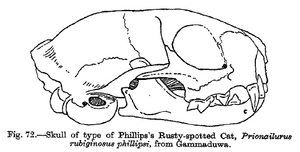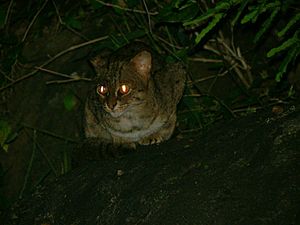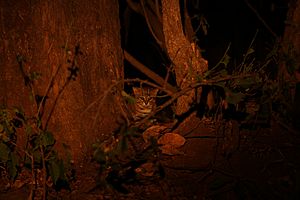Rusty spotted cat facts for kids
Quick facts for kids Rusty-spotted Cat |
|
|---|---|
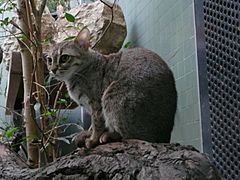 |
|
| Conservation status | |
| Scientific classification | |
| Kingdom: | |
| Phylum: | |
| Class: | |
| Order: | |
| Family: | |
| Genus: | |
| Species: |
P. rubiginosus
|
| Binomial name | |
| Prionailurus rubiginosus (Geoffroy Saint-Hilaire, 1831)
|
|
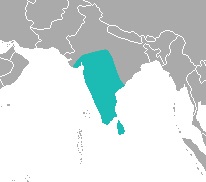 |
|
| Rusty-spotted cat range | |
The rusty-spotted cat (Prionailurus rubiginosus) is one of the smallest wild cats in the world. It gets its name from the rusty-brown spots on its fur. These tiny cats were first found in India and Sri Lanka. Later, in 2012, they were also seen in Nepal.
Since 2016, the number of rusty-spotted cats in the wild has been decreasing. Their homes, especially deciduous forests, are being lost or damaged. Because of this, they are now listed as Near Threatened on the IUCN Red List. This means they could become endangered if we don't protect them.
Contents
What Does a Rusty-Spotted Cat Look Like?
The rusty-spotted cat is the smallest wild cat in Asia. It's about the same size as the black-footed cat, which is the smallest wild cat in the world. These cats are only about 35 to 48 centimeters (14 to 19 inches) long. Their tail adds another 15 to 30 centimeters (6 to 12 inches).
They are very light, weighing only 0.9 to 1.6 kilograms (2 to 3.5 pounds). Their fur is mostly grey with rusty-colored spots on their back and sides. Their belly is white with large dark spots. The tail is thick and about half the length of their body. It has less clear spots. Each side of their head has six dark stripes that go across their cheeks and forehead.
Where Do Rusty-Spotted Cats Live?
Rusty-spotted cats live in a few specific places. They are mostly found in moist and dry deciduous forests. They also live in scrubland and grasslands. However, you probably won't find them in evergreen forests. They like places with thick plants and rocky areas where they can hide.
These cats have been seen in several parts of India. This includes eastern Gujarat and the Gir Wildlife Sanctuary and National Park. They are also in the Tadoba-Andhari Tiger Reserve and Nagzira Wildlife Sanctuary in Maharashtra. Camera traps have even shown them in the Pilibhit Tiger Reserve.
In western Maharashtra, some rusty-spotted cats live near farms. This is because there are many rodents there for them to hunt. They were also photographed in Kalesar National Park in Haryana in 2014 and 2015.
In Nepal, a rusty-spotted cat was first photographed in Bardiya National Park in 2012. They were also seen in Shuklaphanta National Park in 2016.
How Do Rusty-Spotted Cats Behave?
We don't know much about how rusty-spotted cats act in the wild. But we do know some things from cats living in zoos. They are mostly active at night, but they can also be active for short times during the day. Most wild cats have also been seen after dark.
Some rusty-spotted cats have been seen hiding in trees and caves. Cats in zoos mark their territory by spraying urine. This helps them tell other cats that an area is their home.
What Do Rusty-Spotted Cats Eat?
Rusty-spotted cats mainly eat rodents and birds. They might also hunt lizards, frogs, and insects. They hunt mostly on the ground. They move very quickly to catch their prey. If a bigger predator is nearby, they will climb trees to stay safe.
Reproduction and Life Cycle
A female rusty-spotted cat finds a safe, hidden place to make a den. She gives birth to one or two kittens. The kittens are born after about 65 to 70 days. When they are born, they are very tiny. They weigh only 60 to 77 grams (2.1 to 2.7 ounces). For comparison, a regular domestic cat kitten usually weighs more at birth.
At birth, rusty-spotted cat kittens have rows of black spots. They grow up quickly and reach adulthood around 68 weeks old. By this time, their fur changes to the unique rusty blotches of an adult cat. In zoos, rusty-spotted cats have lived for up to twelve years. We don't know how long they live in the wild.
Threats to Rusty-Spotted Cats
One big problem for rusty-spotted cats is that their natural homes are disappearing. More and more land is being used for farming and human settlements in India and Sri Lanka. Even though these cats have been seen in farmed areas, we don't know if they can truly survive there in the long term.
Sometimes, rusty-spotted cat skins have been found for sale. In some places, people hunt them for food. They are also sometimes hunted if people think they are harming farm animals.
Images for kids
See also
 In Spanish: Gato herrumbroso para niños
In Spanish: Gato herrumbroso para niños



